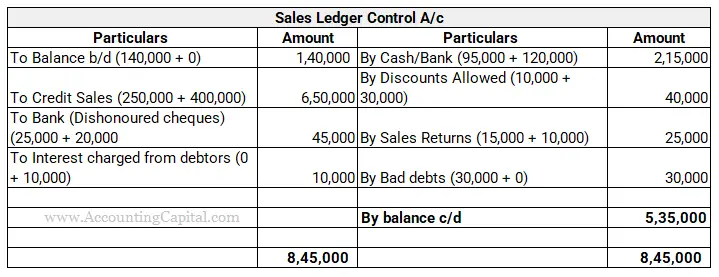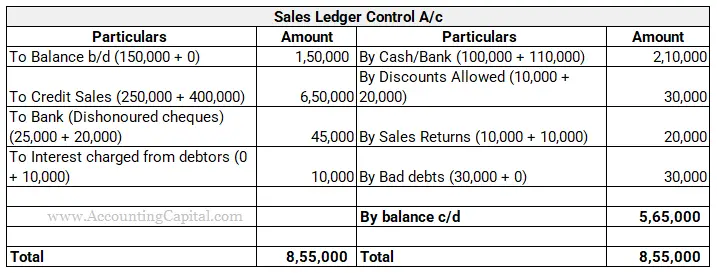Overview of Sales Ledger Control Account
A sales Ledger Control Account (SLCA) is a summarized ledger of all the trade debtors of the entity. This Control Account typically looks like a “T-account” or a replica of an Individual Trade Receivable (Debtor) account. But instead of containing transactions of invoices, returns, and receipts, etc related to one debtor, it contains summarized transactions of invoices, returns, and receipts, etc related to all the debtors of the business.
A sales Ledger Control Account is also referred to as a “Trade Debtors Control Account”. It indicates the total amount the debtors owe to the business entity at a particular point in time. Therefore, it is a “short-term asset” for the business entity and forms part of the balance sheet.
Thus, the Sales Ledger Control Account is debited if its balance increases & credited if its balance decreases. The balance of the SLCA should equal the sum of the balances of the individual customer accounts. If discrepancies arise, then they should be investigated.
As per the Modern Rules of Accounting
| Account | Increase | Decrease |
|---|---|---|
| Asset | Debit (Dr.) | Credit (Cr.) |
Sales Ledger Control Account (asset) is Debited (Dr.) when increased & Credited (Cr.) when decreased.
Why is it like this?
Since it indicates the total trade receivables, it shows a debit balance and the modern rule of accounting cannot be broken under any circumstances.
How is it done?
Suppose the following were during the year transactions with the Debtors Sugar Inc. & Chocolate Inc. along with the outstanding balance as of 31/12/20×2.
| Particulars | Sugar Inc. | Chocolate Inc. |
| Opening balance | 140,000 | – |
| Credit Sales | 250,000 | 400,000 |
| Discount allowed | 10,000 | 30,000 |
| Sales returns | 15,000 | 10,000 |
| Payment received | 95,000 | 120,000 |
| Bad Debts | 30,000 | – |
| Interest charged on the overdue amount | – | 10,000 |
| Dishonored cheques | 25,000 | 20,000 |
| Outstanding balance as of 31/12/20×2 | 265,000 | 270,000 |
Sales Ledger Control Account for the year 01/01/20×2 to 31/12/20×2 will be presented as follows-

The balance of SLCA ie. 535,000 is equal to the sum of the balance of individual outstanding debtors ie. 265,000 + 270,000 = 535,000.
You can see that the transactions which increase the balance of SLCA are debited & decrease the balance are credited. Also, it is depicting a debit balance.
As per the Golden Rules of Accounting
| Account | Rule for Debit | Rule for Credit |
|---|---|---|
| Personal | Debit the Receiver | Credit the Giver |
The Sales Ledger Control Account (asset) is debited as per the Golden Rules.
The individuals and other organizations that have direct transactions with the business are called personal accounts. SLCA indicates total trade receivables at a given point in time, and since trade receivables are personal accounts, SLCA also operates according to the golden rule for personal accounts.
As per the golden rules of accounting (for personal accounts), assets are debited. In other words, the giver of the benefit is a liability to the one who receives it.
Example
Suppose the following were during the year transactions with the Debtors Tea Inc. & Coffee Inc. along with the outstanding balance as of 31/12/20×2.
| Particulars | Tea Inc. | Coffee Inc. |
| Opening balance | 150,000 | – |
| Credit Sales | 250,000 | 400,000 |
| Discount allowed | 10,000 | 20,000 |
| Sales returns | 10,000 | 10,000 |
| Payment received | 100,000 | 110,000 |
| Bad Debts | 30,000 | – |
| Interest charged on the overdue amount | – | 10,000 |
| Dishonored cheques | 25,000 | 20,000 |
| Outstanding balance as of 31/12/20×2 | 275,000 | 290,000 |
Sales Ledger Control Account for the year 01/01/20×2 to 31/12/20×2 will be presented as follows-

The balance of SLCA ie. 565,000 is equal to the sum of the balance of individual outstanding debtors ie. 275,000 + 290,000 = 565,000.
You can see that SLCA is depicting a debit balance.
Sales Ledger Control Account in Trial Balance
SLCA shows a debit balance in the trial balance. A trial balance example showing a debit balance for SLCA is provided below.

